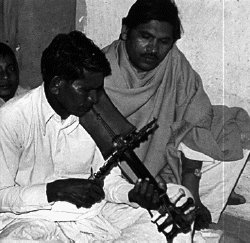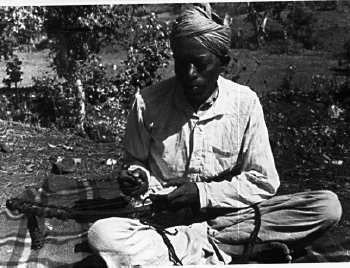The Pardhan people of Dindori District,
Madhya Pradesh (M.P.), India
 |
The Pardhan people are wheat farmers in the broad Narmada River valley. They are musicians to the neighboring Gond people, who are also wheat farmers. A Pardhan man who follows the tradition of mangteri plays the bana, a three-string fiddle, and after the harvest season each year travels to perform epic songs for his Gond patron families. His performances are for entertainment, but he is also regarded as an emissary of the local deity, and his visit brings blessings to the family he visits. The photo at left, taken in Bachargaon village in 1982, shows Babu Lal Paraste playing the bana as his son K.C. Paraste listens. To hear Babu Lal Paraste performing, click here. |
|
A small number of Pardhan musicians play a harp instead of the bana. It is cradled in the lap and played with a plectrum as a rhythmic accompaniment to singing. It is one of the rarest instruments in India, a relic of Buddhist times. It appears on 2000-year old Buddhist stupa reliefs in Central India. This is Ram Prasad Pandro playing the bin-baja, as the instrument is called. To hear an example of the bin-baja,
|
 |
I spent several months with the Pardhan people in Rahangi Village in 1982, traveling with the musicians and making recordings of the bana and harp. For further information, see my articles, "The Harp in India Today," in Ethnomusicology, 1985, and "The bana, epic fiddle of Cenral India," in Asian Music, 2000.
My films of the bana and the harp, along with a variety of other instruments, are featured on the DVD Village and Town Music of India and Nepal, produced by Lyrichord. See VIDEOTAPES for details.